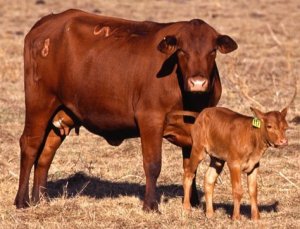
St. Croix, the largest of the Virgin Islands in the Caribbean, is one of the toughest environments cattle have faced. People have tried for over a hundred years to find just the right breed to thrive in the tropical heat.
One of the first major successes was the N’Dama from West Africa, imported to St. Croix in the mid- to late 1800s. This hardy, horned breed was originally pressed into service as a draft ox on sugar plantations. But the people of St. Croix wanted more than just pulling power—they wanted beef, and the N’Dama was a little too bony for that job.
In 1918, Bromley Nelthropp began an experiment. He had seen other ranchers test a variety of beef breeds, but all of them hailed from cooler climates and suffered terribly in the tropical summers. Perhaps crossbreeding was the key. Nelthropp bought several Red Poll bulls from nearby Trinidad and began crossing them with his father’s N’Dama cattle. With rigorous selection, Nelthropp worked to created a hardy, heat-tolerant breed with a good yield of quality beef. By the mid-1940s, he had succeeded.
At the beginning of the 1950s, the Nelthropp family changed their focus to dairy production, dispersing their beef herd to other cattle breeders on St. Croix. The timing was perfect for the islanders, because by then the sugar industry was in decline. The new breed, called the Senepol, became the backbone of a thriving grassfed beef industry. The USDA established a four-point program in 1976 to foster this economic shift on St. Croix. The four points were:
- Establishing a breed registry.
- Setting up performance tests.
- Comparing the performance of the Senepol to that of other breeds.
- Exporting Senepols to provide additional income to the island.
The exports began in 1977 when a plane carrying 22 Senepol cows landed in the southern United States. The breed quickly caught on in its new home thanks to the same hardiness and heat tolerance that made it a success in the Virgin Islands. The Senepol now has a loyal following in the South, where it has become increasingly popular for grass-based beef programs.
Uses
The Senepol is primarily used for beef production in low-input systems, whether as a purebred or in a crossbreeding program. However, it can also be crossed with dairy breeds to produce heat-tolerant milk cows.
Temperament

Both bulls and cows are gentle and docile in this breed. The main risk with Senepols comes from over-affectionate cattle crushing their owners in tight places.
Health
The Senepol can withstand a host of diseases. Not surprisingly, it is particularly resistant to sun-related problems, such as pinkeye and cancer.
Senepols may not thrive as well in confinement systems.
Pros
- Hardiness.
- Excellent parasite resistance.
- Extreme heat tolerance.
- Low maintenance requirements.
- Strong will to graze even in the heat of the day.
- Ability to thrive on poor-quality forage.
- Excellent longevity; many cows remain productive up to 18 years of age.
- Good fertility.
- Calving ease.
- Calf vigor.
- Excellent mothering instincts.
- Rapid growth.
- Easy fleshing ability.
- Exceptionally tender and tasty beef on grass alone.
- More hybrid vigor than many standard breeds used for crossbreeding.
Cons
- Poor cold tolerance.
- Late maturity.


